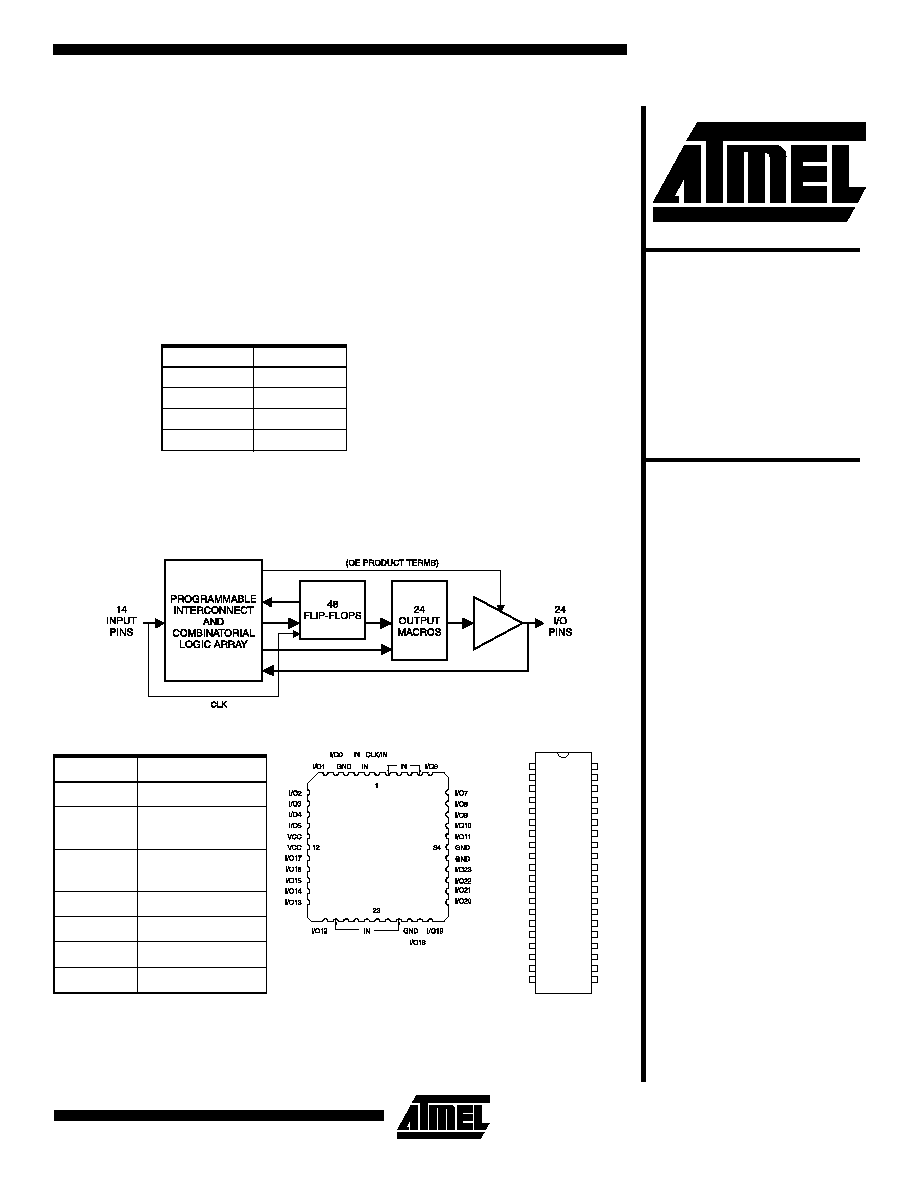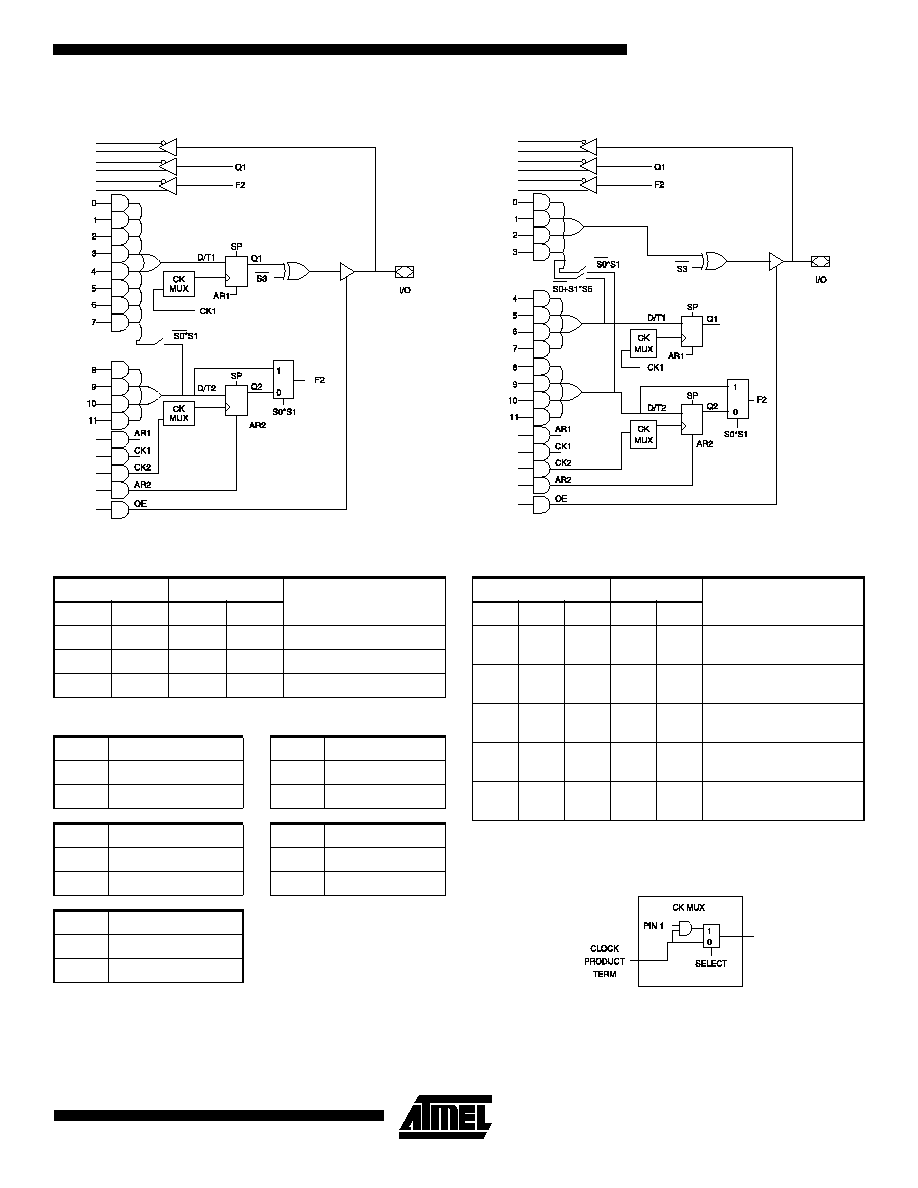
1
Note:
For ATV2500BQ and
ATV2500BQL (PLCC/LCC
package only) pin 4 and
pin 26 connections are not
required.
Pin Configurations
Pin Name
Function
IN
Logic Inputs
CLK/IN
Pin Clock and
Input
I/O
Bidirectional
Buffers
I/O 0,2,4..
"Even" I/O Buffers
I/O 1,3,5..
"Odd" I/O Buffers
GND
Ground
VCC
+5V Supply
Features
·
High Performance, High Density Programmable Logic Device
Typical 7 ns Pin-to-Pin Delay
Fully Connected Logic Array With 416 Product Terms
·
Flexible Output Macrocell
48 Flip-Flops - Two per Macrocell
72 Sum Terms
All Flip-Flops, I/O Pins Feed In Independently
Achieves Over 80% Gate Utilization
·
Enhanced Macrocell Configuration Selections
D- or T-Type Flip-Flops
Product Term or Direct Input Pin Clocking
Registered or Combinatorial Internal Feedback
·
Several Power Saving Options
·
Backward Compatible With ATV2500H/L Software
·
Proven and Reliable High Speed UV EPROM Process
·
Reprogrammable - Tested 100% for Programmability
·
40-Pin Dual-In-Line and 44-Pin Lead Surface Mount Packages
Block Diagram
Device
I
CC
, Stand-By
ATV2500B
110 mA
ATV2500BQ
30 mA
ATV2500BL
2 mA
ATV2500BQL
2 mA
Rev. 0249F06/98
High-Speed
High-Density
UV Erasable
Programmable
Logic Device
ATV2500B
DIP
LCC/PLCC
1
2
3
4
5
6
7
8
9
10
11
12
13
14
15
16
17
18
19
20
40
39
38
37
36
35
34
33
32
31
30
29
28
27
26
25
24
23
22
21
CLK/IN
IN
IN
I/O0
I/O1
I/O2
I/O3
I/O4
I/O5
VCC
I/O17
I/O16
I/O15
I/O14
I/O13
I/O12
IN
IN
IN
IN
IN
IN
IN
IN
I/O6
I/O7
I/O8
I/O9
I/O10
I/O11
GND
I/O23
I/O22
I/O21
I/O20
I/O19
I/O18
IN
IN
IN

ATV2500B
2
Functional Logic Diagram ATV2500B
Note:
1.
Not required for PLCC versions of ATV2500BQ or ATV2500BQL, making them compatible with ATV2500H and ATV2500L
pinout.

ATV2500B
3
Description
The ATV2500Bs are the highest density PLDs available in
a 40- or 44-pin package. With their fully connected logic
array and flexible macrocell structure, high gate utilization
is easily obtainable.
The ATV2500Bs are organized around a
single universal
and-or array
. All pin and feedback terms are always avail-
able to every macrocell. Each of the 38 logic pins are array
inputs, as are the outputs of each flip-flop.
In the ATV2500Bs, four product terms are input to each
sum term. Furthermore, each macrocell's three sum terms
can be combined to provide up to 12 product terms per
sum term with
no performance penalty
. Each flip-flop is
individually selectable to be either D- or T-type, providing
further logic compaction. Also, 24 of the flip-flops may be
bypassed to provide internal combinatorial feedback to the
logic array.
Product terms provide individual clocks and asynchronous
resets for each flip-flop. The flip-flops may also be individu-
ally configured to have direct input pin clocking. Each out-
put has its own enable product term. Eight synchronous
preset product terms serve local groups of either four or
eight flip-flops. Register preload functions are provided to
simplify testing. All registers automatically reset upon
power up.
Several low power device options allow selection of the
optimum solution for many power-sensitive applications.
Each of the options significantly reduces total system
power and enhances system reliability.
Functional Logic Diagram Description
The ATV2500B functional logic diagram describes the
interconnections between the input, feedback pins and
logic cells. All interconnections are routed through the sin-
gle global bus.
The ATV2500Bs are straightforward and uniform PLDs.
The 24 macrocells are numbered 0 through 23. Each mac-
rocell contains 17 AND gates. All AND gates have 172
inputs. The five lower product terms provide AR1, CK1,
CK2, AR2, and OE. These are: one asynchronous reset
and clock per flip-flop, and an output enable. The top 12
product terms are grouped into three sum terms, which are
used as shown in the macrocell diagrams.
Eight synchronous preset terms are distributed in a 2/4 pat-
tern. The first four macrocells share Preset 0, the next two
share Preset 1, and so on, ending with the last two macro-
cells sharing Preset 7.
The 14 dedicated inputs and their complements use the
numbered positions in the global bus as shown. Each
macrocell provides six inputs to the global bus: (left to
right) feedback F2
(1)
true and false, flip-flop Q1 true and
false, and the pin true and false. The positions occupied by
these signals in the global bus are the six numbers in the
bus diagram next to each macrocell.
Note: 1. Either the flip-flop input (D/T2) or output (Q2) may
be fed back in the ATV2500Bs.

ATV2500B
4
*NOTICE:
Stresses beyond those listed under "Absolute Maxi-
mum Ratings" may cause permanent damage to the
device. This is a stress rating only and functional
operation of the device at these or any other condi-
tions beyond those indicated in the operational sec-
tions of this specification is not implied. Exposure to
absolute maximum rating conditions for extended
periods may affect device reliability.
Note:
1.
Minimum voltage is -0.6V dc which may undershoot
to -2.0V for pulses of less than 20ns. Maximum out-
put pin volt- age is V
CC
+0.75V dc which may over-
shoot to +7.0V for pulses of less than 20ns.
Absolute Maximum Ratings*
emperature Under Bias.................................. -55°C to +125°C
Storage Temperature ..................................... -65°C to +150°C
Voltage on Any Pin with
Respect to Ground ........................................-2.0V to +7.0V
(1)
Voltage on Input Pins
with Respect to Ground
During Programming....................................-2.0V to +14.0V
(1)
Programming Voltage with
Respect to Ground ......................................-2.0V to +14.0V
(1)
Integrated UV Erase Dose..............................7258 W
·
sec/cm
2
Note:
1. Typical values for nominal supply voltage. This parameter is only sampled and is not 100% tested.
DC and AC Operating Conditions
Commercial
Industrial
Military
Operating Temperature (Case)
0°C - 70°C
-40°C - 85°C
-55°C - 125°C
V
CC
Power Supply
5V ± 5%
5V ± 10%
5V ± 10%
Pin Capacitance
(f = 1 MHz, T = 25°C)
(1)
Typ
Max
Units
Conditions
C
IN
4
6
pF
V
IN
= 0V
C
OUT
8
12
pF
V
OUT
= 0V

ATV2500B
5
Output Logic, Registered
(1)
Output Logic, Combinatiorial
(1)
Note:
1.
These diagrams show equivalent logic functions, not necessarily the actual circuit implementation.
Note:
1. These four terms are shared with D/T1.
Clock Option
S2 = 0
Terms in
Output Configuration
S1
S0
D/T1
D/T2
0
0
8
4
Registered (Q1); Q2 FB
1
0
12
4
(1)
Registered (Q1); Q2 FB
1
1
8
4
Registered (Q1); D/T2 FB
S3
Ouput Configuration
S6
Q1 CLOCK
0
Active Low
0
CK1
1
Active High
1
CK1 · PIN1
S4
Register 1 Type
S7
Q2 CLOCK
0
D
0
CK2
1
T
1
CK2 · PIN1
S5
Register 2 Type
0
D
1
T
S2 = 1
Terms in
Output Configuration
S5
S1
S0
D/T1
D/T2
X
0
0
4
(1)
4
Combinatorial (8 Terms);
Q2 FB
X
0
1
4
4
Combinatorial (4 Terms);
Q2 FB
X
1
0
4
(1)
4
(1)
Combinatorial (12 Terms);
Q2 FB
1
1
1
4
(1)
4
Combinatorial (8 Terms);
D/T2 FB
0
1
1
4
4
Combinatorial (4 Terms);
D/T2 FB




